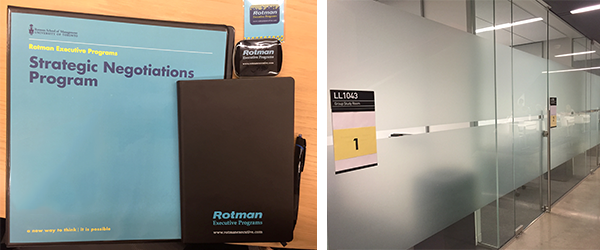
(Jim Fisher, Rose Patten and Joseph Natale at the networking reception)
“I believe that everyone has within themselves the capability to lead if they only know how to break the idea of leadership into understandable chunks and then integrate it back into a more powerful whole,” Jim Fisher, The Thoughtful Leader.
Earlier this month, I got to sit in a room filled with executives from all sectors of Canada as they started their thoughtful journey through the Rotman Executive Leadership Program.
This transformational program understands that leadership cannot be learned in a week and that it takes time to develop new skills. So, five days of in-class learning are supported with pre- and post- programming to ensure the transfer of leadership skills are strategically reinforced through coaches and advisory boards over the span of eight months.
A month before class, participants completed a 360 assessment. This gave them a robust snapshot of how they’re viewed not just by their direct supervisors but also by their co-workers and direct reports.
Armed with a look at their leadership strengths and competencies for improvement, the class started the program on Monday, May 2 with academic directors Rose Patten, Special Advisor to the President and CEO of BMO Financial Group, board member at SickKids Foundation, and Executive in Residence at Rotman and Jim Fisher, Rotman’s Professor Emeritus and an industry veteran with a long history of leadership in some of Canada’s key organizations. He also happened to create Rotman’s very first Leadership course.
Jim shared his powerful 9-box leadership model, a guide to what leaders need to do well to succeed. Addressing the ‘Big 8’, Rose covered the capabilities each leader needs to develop to implement the 9-box. These two models intersect to help each participant work on a personal leadership development plan.

Faculty and Coaches
Through the course of the week, an all-star cast of Rotman’s finest helped participants understand and practice these leadership skills. Here’s just a snippet of what went on in the classroom:
- Nouman Ashraf, a senior fellow at Rotman and a frequent consultant to some of Canada’s biggest organizations, and a firecracker presenter, kicked us off with a lively demonstration of Integrative Thinking: a model-based problem-solving method that embraces tension in opposable ideas to generate innovation. He also covered a leader’s role in creating a safe environment to foster integrative thinking.
- Stefanie Schram of Rotman’s DesignWorks took us through a 5-step cascading model on how strategy really works including case studies on the model in practice. Stephanie has used this model while working with some Fortune 500 companies and emphasized the importance of paying equal attention to each step in the cascade.
- Stéphane Côté, director of Rotman’s PhD program who serves on editorial boards for a number of publications, discussed how leaders can use emotional intelligence to improve self-awareness and regulation as well as any social environment. The class then worked in teams on a case to test the model.
- Geoff Leonardelli, Rotman’s expert on teams, organizational behavior and managerial negotiations, covered the five different models for team-based decisions and had the class involved in a highly engaging team exercise to test their understanding of the concepts.
- John Oesch, a published authority in organizational behavior, decision-making and negotiations covered the challenges and best practices around executive communication and got the class to practice using a difficult conversation case.
Additionally, over the course of four days, Professor Julie McCarthy, who has developed effective performance management systems for both private and public corporations, used a four-part model to help our executives develop physical, mental, emotional and value-driven resiliency with immediately applicable ways to thrive in what we now accept as continuous partial attention environments.
One of my personal highlights was meeting and listening to Joseph Nataleduring our networking event. The former CEO of Telus was a powerful and inspiring speaker who walked us through the role different people and experiences in his life played in shaping his success and understanding of leadership. He also shared 9 characteristics he looks for in leaders which our participants found particularly insightful.
Each day, Jim and Rose led debrief and closing sessions to help participants tie in learnings to understand how they fit in the 9 box and Big 8 models. In addition to the examples they provided from their work with various organizations over the years, I personally also enjoyed Rose’s impeccable taste in fashion.
On the last day, each team worked with a coach to develop their personal action plans. Then, over the course of the next few months, they will work with their coaches and advisory board members to implement their plans. At their graduation ceremony in October, we’ll have the privilege of hearing how they’ve grown as leaders, their impact on their teams and their organizations. Based on feedback from the last group, we’ve no doubt it will be an inspiring graduation.
To learn more about our programs connect with me at joanne.goveas@rotman.utoronto.ca








